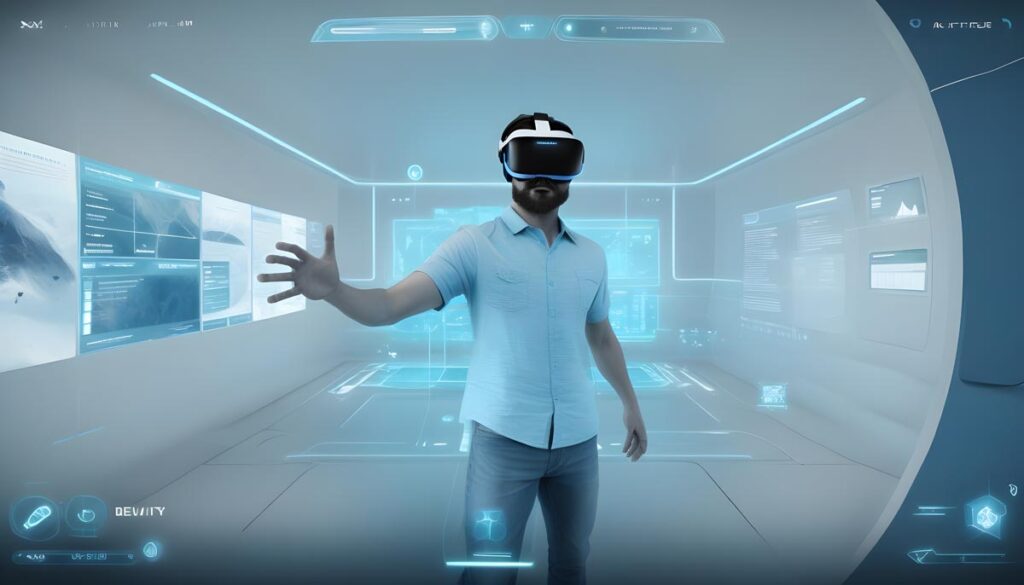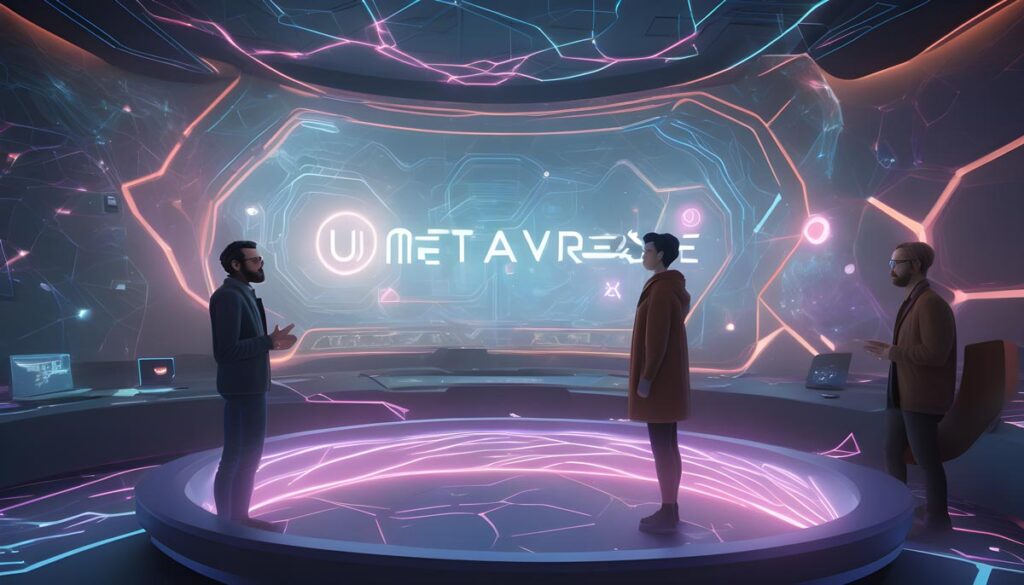As the concept of the metaverse becomes increasingly prominent in our digital society, the role of UI/UX designers is taking on new significance. The metaverse, a collective virtual shared space, requires immersive and seamless user experiences to enhance user engagement and interaction. UI/UX designers play a crucial role in shaping the design and functionality of the metaverse, ensuring that users can navigate and engage with virtual environments effortlessly.
In this blog post, we will explore the emerging role of UI/UX designers in the metaverse and the skills they need to thrive in this rapidly evolving digital landscape.
By purchasing through the links on this page, you are giving us the opportunity to earn a commission. Your support is greatly appreciated!
Understanding the Metaverse and its impact on user experience
In order to fully grasp the emerging role of UI/UX designers in the metaverse, it is crucial to understand the concept of the metaverse itself and its implications for user experience. The metaverse is not simply a virtual reality or augmented reality space; it is a collective virtual shared space where users can engage, interact, and create within a digital realm.
With the metaverse, traditional limitations of physical space and time are transcended, opening up endless possibilities for immersive experiences. UI/UX designers have the opportunity to shape these experiences through their expertise in user-centered design principles. They must create intuitive interfaces that enable users to seamlessly navigate the metaverse and engage with virtual environments.
In the metaverse, user experience goes beyond simply designing visually appealing interfaces. UI/UX designers must consider factors such as spatial awareness, haptic feedback, and social interactions to enhance the overall user experience. Additionally, they will need to leverage emerging technologies such as virtual reality, augmented reality, and mixed reality to create these immersive experiences.
As the metaverse continues to evolve, UI/UX designers must stay at the forefront of technological advancements and continuously adapt their skills to meet the ever-changing needs of users. In the next section, we will dive deeper into the specific skills and expertise required for UI/UX designers to thrive in this rapidly evolving digital landscape. Stay tuned!
The expanding role of UI/UX designers in the Metaverse

With the rapid growth of the metaverse, the role of UI/UX designers is expanding like never before. They are no longer limited to designing interfaces for traditional websites and applications. UI/UX designers now have the opportunity to create immersive experiences that blur the line between the digital and physical worlds.
One of the key areas where UI/UX designers are making a significant impact in the metaverse is in the design of virtual worlds and environments. They are responsible for creating visually stunning landscapes, interactive objects, and compelling characters that users can explore and interact with. This requires a deep understanding of the principles of game design, storytelling, and user engagement.
Furthermore, UI/UX designers play a crucial role in designing social interactions within the metaverse. They must consider how users communicate and collaborate with each other in virtual spaces, and create seamless and intuitive interfaces for these interactions. This involves designing features such as chat systems, voice communication, and virtual avatars that can represent users in the digital realm.
Another important aspect of the expanded role of UI/UX designers in the metaverse is the integration of emerging technologies. They must stay up-to-date with the latest advancements in virtual reality, augmented reality, and mixed reality in order to create truly immersive experiences. This might include designing interfaces that seamlessly integrate with wearable devices or designing touch-based interactions that take advantage of haptic feedback.
In addition to technical skills, UI/UX designers in the metaverse need to possess strong problem-solving and critical thinking abilities. The metaverse presents unique challenges and constraints that require designers to think outside the box and come up with creative solutions.
As the metaverse continues to evolve, the role of UI/UX designers will only become more integral. Their ability to create intuitive and engaging experiences will be instrumental in shaping the future of digital interactions.
The importance of seamless user interfaces in virtual environments
In the metaverse, user interfaces (UI) play a crucial role in guiding users through virtual environments and enabling them to interact with various elements. From navigation menus to interactive objects, UI/UX designers must ensure that these interfaces are intuitive, seamless, and user-friendly.

Challenges in Designing UI for Virtual Environments:
- Striking a balance between functionality and immersion is a key challenge in UI design for virtual environments.
- Providing easy access to essential features is crucial, but overly cluttered or intrusive interfaces can break immersion and hinder user experience.
- UI/UX designers must carefully consider the placement, size, and visual design of elements to create harmony with the virtual environment.
Considerations for VR and AR Devices:
- UI/UX designers need to account for the limitations of virtual reality (VR) and augmented reality (AR) devices.
- These devices often have limited field of view and input capabilities, requiring thoughtful UI design to enhance usability and prevent user frustration.
Accessibility in the Metaverse:
- Designing accessible interfaces is paramount in the metaverse.
- UI/UX designers should consider users with disabilities and incorporate alternative input methods, such as gesture-based or voice-based interactions, for a more inclusive experience.
By focusing on creating seamless and user-friendly interfaces, UI/UX designers can greatly enhance the overall user experience in virtual environments.
Strategies for designing immersive user experiences in the Metaverse
Creating immersive user experiences in the metaverse requires careful consideration and the use of effective strategies. UI/UX designers play a pivotal role in shaping these experiences, making it essential for them to employ the right tools and techniques.
| Strategy | Key Points |
|---|---|
| Simplicity and Minimalism | ♦ Prioritize clean and clutter-free interfaces. ♦ Allow users to navigate seamlessly without distractions. ♦ Focus on core elements, enhancing the metaverse experience. |
| Spatial Design Principles | ♦ Leverage the three-dimensional nature of the metaverse. ♦ Create interfaces seamlessly integrated within the virtual environment. ♦ Boost immersion and provide users with a heightened sense of presence. |
| Feedback and Responsiveness | ♦ Emphasize visual, auditory, and haptic feedback for user interactions. ♦ Reinforce realism and engagement in the metaverse. ♦ Design feedback to be easily understood and interpreted by users. |
| Gamification Elements | ♦ Introduce challenges, rewards, and achievements into the user experience. ♦ Keep users motivated and engaged within the dynamic metaverse environment. |
| Continuous Testing and Iteration | ♦ Conduct regular user testing to refine the metaverse user experience. |
Collaboration between UI/UX designers and developers in the Metaverse
Collaboration between UI/UX designers and developers plays a crucial role in creating successful user experiences in the metaverse. While designers are responsible for crafting the visual and interactive elements, developers bring these designs to life by coding the necessary functionalities.

To ensure effective collaboration, it is important for UI/UX designers and developers to have a clear understanding of each other’s roles and expertise. Designers should communicate their design visions and requirements to developers, while developers should provide insights and guidance on the technical feasibility of these designs.
One effective way to facilitate collaboration is through the use of prototyping tools and platforms that allow designers and developers to work together seamlessly. These tools enable real-time feedback and iteration, ensuring that both parties are aligned in their objectives and can make necessary adjustments throughout the design and development process.
Regular meetings and discussions between UI/UX designers and developers are also essential for maintaining open lines of communication. By fostering a collaborative and inclusive environment, potential issues can be identified and resolved early on, leading to more efficient workflows and better end results.
The future of UI/UX design in the Metaverse
As technology continues to evolve and the use of the metaverse becomes more prevalent, the role of UI/UX designers will become even more critical. In the next section, we will discuss the future prospects for UI/UX designers in this exciting and emerging field.
One of the key aspects that UI/UX designers will need to consider is the seamless integration of virtual and augmented reality experiences into the metaverse. As users become more accustomed to interacting with digital environments, designers will need to create intuitive and immersive interfaces that enhance the overall user experience.
Another challenge that UI/UX designers will face is the diversity of devices and platforms that users will engage with in the metaverse. From head-mounted displays to smartphones and tablets, designers will need to adapt their designs to ensure consistency and usability across all these devices.
Furthermore, personalization will play a significant role in the future of UI/UX design in the metaverse. With the ability to gather vast amounts of user data, designers can create tailored experiences that cater to individual preferences and needs. This level of personalization will not only enhance user satisfaction but also drive deeper engagement within the metaverse.
Challenge:
Harmonizing virtual and augmented reality experiences.
Approach:
Design intuitive interfaces for enhanced user immersion.
Challenge:
Adapting to a variety of devices and platforms.
Approach:
Ensure consistent, user-friendly designs across head-mounted displays, smartphones, and tablets.
Challenge:
Utilize vast user data for tailored experiences.
Approach:
Drive satisfaction and deeper engagement in the metaverse.
Conclusion: Embracing the opportunities and challenges of designing for the Metaverse
As the metaverse continues to grow and evolve, it is clear that UI/UX designers will play a crucial role in shaping the digital landscapes of the future. From integrating virtual and augmented reality experiences to ensuring consistency across diverse devices and platforms, the challenges are vast. However, the opportunities are equally significant.
By embracing the potential of personalization and leveraging user data, UI/UX designers can create tailored experiences that truly resonate with individuals. This level of customization not only enhances user satisfaction but also drives deeper engagement within the metaverse.
To thrive in this exciting and emerging field, UI/UX designers will need to acquire specific skills and competencies. In the next section, we will explore the key skills that will be in high demand as the metaverse continues to expand. So, stay tuned to discover how you can position yourself for success in the dynamic world of metaverse design.



